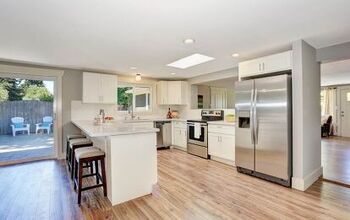A Beginner's Guide To Home Design

Creating a home that looks and feels amazing is one thing, but you also want your home to function well. A cornerstone of good design marries form and function, and you may think you need an interior designer to achieve it. But if your budget has no wiggle room, you can try some DIY design with a few basics.
Get to know your style instead of only following the latest trends, and incorporate things you love into your home. Pay attention to color, lighting, flow, balance and scale when designing the rooms in your house. Choose a focal point in each space, and always consider form and function when pulling together your final look.
You don’t have to attend a prestigious design school to make your house look amazing. Also, as fabulous as it would be to hire a professional designer, it isn’t necessary. However, you need to know some basics and be willing to be bold to design a home that speaks to you.
Interior Design And Decorating Basics
You’ve probably heard the terms interior designer and interior decorator and assumed they’re the same. However, a designer focuses more on the space-planning and functional aspects of a room, while a decorator hones in more on aesthetics. But to achieve good design, you need to be familiar with both of these concepts.
After all, you want your home to look fabulous, but it also needs to function smoothly. According to Forbes, professional designers charge between $50 and $500 an hour for their services. The average is roughly $100 per hour. Still, the final price depends on the designer’s expertise, location, etc. (These numbers are just the design fees — they don’t include any furniture or accessories.)
Therefore, it makes sense to learn a few design fundamentals to create a comfortable home without shelling out thousands.
1. Get To Know Your Style
You might say you’re not sure what your style is when it comes to interior design, however, that’s not necessarily true. You probably do know your style, but maybe you aren’t sure what to call it.
For example, you know you prefer clean lines, natural materials, neutrals, and using fresh greenery in your home. You just don’t realize that there’s a style called organic modern that encompasses these traits.
You don’t have to become an expert on every design style (i.e. modern farmhouse, mid-century modern, Scandinavian, Japandi, etc.). Instead, focus on looking through pictures of homes and checking out your friends’ houses and other spaces to get a feel for what you’re drawn to.
Get to know the things you like, love, and can’t stand. Then, look for pieces that fit your preferences. As you do this, you’ll start to get a feel for your style. You’ll most likely realize your style is actually a mix of several design trends.
2. Concentrate On Colors
Undoubtedly, you have a few favorite colors and some that you don’t like. If you’re not sure, take a peek in your closet. Your clothing often reflects your color preferences.
Choosing colors for your home doesn’t have to be complicated. Think about the colors you like and how you want your house to make you feel. If you take the time to figure out your style, you’ll have a bit more inspiration for color choices.
It’s important to dig a little deeper into color theory and how different hues affect your mood. (You don’t want to paint your bedroom walls red if your goal is a relaxing retreat.) You also need to consider how the different colors you choose go together (color harmony).
A color wheel is an excellent tool to help you with this. Using colors that are closer together on the wheel creates more calming spaces. Alternatively, using the colors on opposite sides of the wheel creates more contrast and drama.
Extra Rules About Color in Design
There are a couple of other basics to remember when using colors in your home. As you make your selections, keep these design basics in mind:
- The 60-30-10 Rule — Your main color should show up in about 60% of your space and secondary color in roughly 30%. The remaining 10% is for your accent color. You can add neutrals to break up colors, depending on your overall look. (In some cases, a neutral may be one of your 60-30-10 colors.)
- The Rule Of Three — Your main color (the 60%) is already likely throughout the space. Make sure your secondary and accent colors show up in three places around the entire room. Dispersing the colors like this helps draw the eye through the space and keep it moving, which helps with visual balance and flow. (The rule of three also applies to creating vignettes with decor — grouping three items, and so on.)
- Always Test Your Colors — Get sample jars of your colors and paint large swatches on poster board to hang around your space. See how the colors look in different lighting, during the day and night, and with other colors. Also get samples whenever possible of fabrics, flooring, tiles, etc. to test everything out in the actual space.
- Embrace Tints, Tones And Shades — Create harmony and interest by choosing variations of the same hue. Shades of color add black to a hue, tones add gray and tints add white.
3. Pay Attention To Balance And Scale
Choose pieces that fit the scale of your room. For example, oversized, bulky furniture becomes overpowering in a small space. On the contrary, small, low-profile furniture gets lost in an expansive room with 10-foot ceilings.
When you look at a room, imagine it as a see-saw. Is the see-saw balanced or is one side stuck in the down position because it’s too heavy? If you have three large pieces of furniture on one side of a room and only one piece on the other, you may need to move one. Or, you could balance things out by adding a tall potted tree or large artwork on the wall, etc.
4. Set A Focal Point
If you arrange your colors well, the eye will travel around the room, but then, it needs somewhere to land. This is where a focal point comes into play. If you don’t have one, a space can seem boring or without purpose. On the other hand, if there are too many, you don’t know where to look and the room feels confusing or busy.
In some cases, the obvious focal point may be a fixed detail, like a fireplace or oversized picture window with an incredible view. In other rooms, you may need to create a focal point. If so, choose something amazing and place it on the wall opposite of the room’s main entrance.
The rest of your design should center around the focal point. Examples of common focal points (in various rooms) are fireplaces, televisions, large artwork, beds, oversized windows, and accent walls.
5. Don’t Underplay Lighting
Lighting is one of the most important parts of a design, but many people treat it like an afterthought. Make sure you have the right kind of lighting for the room. Think about how the room should make you feel and what you want to accomplish there. For example, a bedroom will have very different lighting from a kitchen or a home gym.
A single, overhead light fixture is not enough. Incorporate ambient and task lighting in your rooms and accent lighting to fill in the gaps.
Ditch the boring, builder-grade boob lights for fixtures that make a statement. Finally, use the same color temperature throughout your home to maintain balance and a cohesive feel.
The next two tips are essential designing basics. They revolve around one vital rule — paying attention to form and function.
6. Test Out The Flow
Space planning is critical to good design. It doesn’t matter how great a space looks if you can’t move around in it. Furniture should have enough space around and between it for people to maneuver easily. A good rule of thumb is to aim for between 14 and 18 inches of space.
Sit in the chairs around the dining table. See how it feels to get in and out of them. What if someone is sitting in the chair next to you? Can you still access your chair?
How close is your bed to the wall? Can you open the closet door without hitting it? If not, is the problem solved if you switch out the closet door for a curtain?
Do you have to close the utensil drawer before you can open the dishwasher? Are you bumping your head on the chandelier? These are all examples of space planning and flow.
7. Consider Your Lifestyle
If you have a small home but host out-of-town guests frequently, a sofa sleeper makes more sense than that fancy, designer couch all over TikTok. Gourmet kitchens are excellent for avid cooks, but if you’re more into take-out, you may need more space for a home office.
Trying to replicate Instagram is fine, but if it doesn’t make sense for your life, it’s more likely to stress you out. It’s like trying to live in someone else’s house. You need to think about your lifestyle when designing your home.
8. Incorporate Items You Love
Yes, there are a handful of interior design rules you should try to never break. However, ultimately, your home should showcase your personality and unique style. If you despise whatever is currently trending in the design world, do not put it in your home.
Likewise, don’t just buy the matching furniture set from the store. Mix and match pieces to provide a more curated, designer look in your space. Look for vintage pieces that tell a story, incorporate your grandmother’s vase that you adore, or give new life to that sweet flea market find.
Do You Need An Interior Designer?
First, want and need are very different things. If you take the time to learn these basics and get familiar with them, then you don’t need a designer. If you’re really struggling, some designers offer a consultation service. They come to your home and offer a few suggestions and recommendations, and then you take over and do the legwork.
However, if you have room to spare in your budget, hiring a professional to put an experienced eye on your home is wonderful. Ultimately, great design is about creating a functional, beautiful space that reflects your style and makes you feel at home. (But always remember, beauty is in the eye of the beholder.)
Related Guides:
- Priceless Tips For Budget-Friendly Design
- 17+ Different Types of Lamps (with Photos)
- How To Make A Daybed Look Like A Couch (6 Ways To Do It!)

Stacy Randall is a wife, mother, and freelance writer from NOLA that has always had a love for DIY projects, home organization, and making spaces beautiful. Together with her husband, she has been spending the last several years lovingly renovating her grandparent's former home, making it their own and learning a lot about life along the way.
More by Stacy Randall













![10 Best Cordless Leaf Blowers – [2022 Reviews & Ultimate Guide]](https://cdn-fastly.upgradedhome.com/media/2023/07/31/9070789/10-best-cordless-leaf-blowers-2022-reviews-ultimate-guide.jpg?size=350x220)













